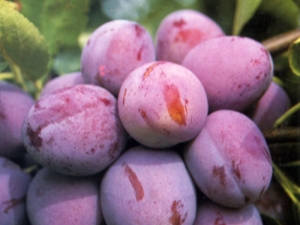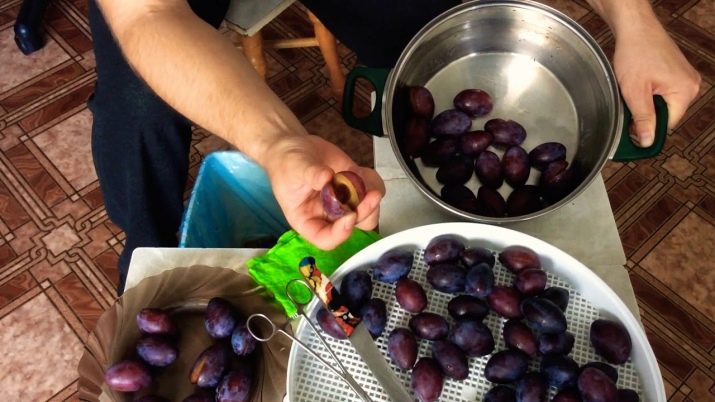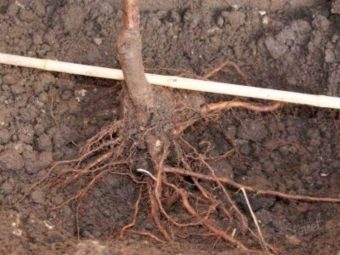Description of the plum variety "Opal"

Plum - one of the most interesting and incredibly hardy fruit trees. Today, there are many varieties of plums, each of them has its own characteristics and characteristics.Those who have already had experience in growing such crops, but want to try a new, unusual variety, experts recommend the variety Opal.
Special features
Opal plum is a dessert variety that many have appreciated for their excellent taste. Sweden is the homeland of the variety, and it was bred in 1926 thanks to the crossing of Rencloda Ulena and Early Favorite plums. Initially, Opal was created in order to grow it on poor soil in adverse conditions.
The tree has an average height, which in a good climate can reach three meters. The crown of such a plum is voluminous and spreading. It is rather simple to form it by cutting off the extra twigs. The leaves have a pleasant light green color with pronounced white or yellowish veins.
Bloom "Opal" begins in the early to mid-May. During flowering, the tree is richly covered with small white flowers with a delicate aroma. The variety is self-fertile, but pollinators are needed to obtain a large number of ovaries. Fruit plum does not begin immediately - after planting the seedling should take at least 3-4 years. The crop is usually abundant, from one tree you can collect 50-55 kg of fruit.
Fruits are round, have a small size. Each weighs about 30 g. They have a purple color with small red patches, but there are also pink variants. The peel is usually thin, with a slight waxy coating. The taste of the plum is quite sweet, but you can feel a slightly sour taste, which gives the fruit its distinctive character. To separate the skin is quite difficult, but the bones from the pulp come off quickly, which is rare among similar varieties.
Advantages and disadvantages
As is clear from the description, the Opal variety has a large number of advantages that allow you to choose it for the garden plot. The main advantages of this type:
- useful and palatable fruits;
- good resistance to diseases and insects;
- a bountiful harvest;
- early ripening;
- unpretentious care;
- simplicity of separation of stones from pulp.
Of course, like any culture, Plum "Opal" has several drawbacks. Among the “pitfalls” of cultivating a variety:
- crop irregularity (plum fruits every two years);
- with too large a crop, fruits are smaller and less tasty;
- the tree does not like strong frosts;
- the sugar content in fruits is high (diabetics and people with overweight are advised to use them very carefully).
Growing technique
It must be remembered that the plum is not transplanted, so you should immediately choose the right place for the tree. It is advisable to choose a large and well-lit area, but with protection from blowing. Sapling have at a distance of not less than three meters from nearby buildings and trees.
Many gardeners recommend planting a plum so that it is closed on the north side, from which cool winds most often blow.
For planting usually take a flat ground. Otherwise, excess air will form and stagnate in the micro-tusks. It is imperative to produce earth, since the plum cannot grow in sour and peaty soil. . For the normal development of the tree suitable loamy soil in combination with humus and a small amount of sand. Groundwater should flow at a depth of 1.5-2 meters.
It is the best of all to get saplings in the fall, and to plant - in the spring. To the trees comfortably overwinter, they are buried in a well-protected from the draft place. To do this, dig a small oblong hole and place the seedlings there. From above, future plums are sprinkled with damp earth and covered with a dense, but breathable cloth or burlap.
Preparation for planting begins in the middle of spring: they remove old roots and weed residues, clear the ground, dig it up and make holes. The soil in combination with the compost is placed on the bottom, a sapling is set on top, the roots are evenly distributed and covered with earth. It is worth remembering that after planting the soil must be mulched.
Care rules
Watering is one of the main stages in the care of Opal. Watering a tree is recommended no more than once every 10 days. It must be remembered that this variety does not tolerate water stagnation. It may even lead to the death of the seedling. With an excess of moisture, the fruits begin to crack, shrink and quickly fall off. In the period of heavy rains or prolonged rains, immature fruits can also be collected. It will be better if they mature at room temperature.
Regular weeding and cleaning of weeds is another important nuance. In many cases, timely removal of weeds helps reduce the risk of pests and a variety of diseases. A good idea would be planting crops on the site, attracting beneficial insects, honey plants (clover, phacelia, flowers).
Every few years, it is worth clearing the old bark of the tree and making whitewash. Such preventive measures will help protect the tree from ticks.
As a rule, in the first two years, the drain does not need fertilizers at all, but then it must be applied regularly. When it comes the third year after planting, the tree is fertilized with one bucket of humus, mixed with a tablespoon of superphosphate and ammonium nitrate. In the spring, the plum requires nitrogen fertilization, and in the fall, potassium and phosphorus bring many benefits. It is worth noting that in the case of a rainy summer, it is better to halve the spring fertilizer and double the autumn one.
Be sure to remember that "Opal" is not completely self-propelled, it requires additional pollinators. As pollinators, you can use the varieties “Kleimen”, “Volga beauty” or the Czech “Renklod Altana”. If you plan to leave "Opal" as the only variety on your site, then nearby cherry plum will also be suitable for increasing fruiting.
Reviews
Gardeners leave very good reviews on the Opal plum variety. First of all, everyone notes the delicate sweetish taste of the fruit. The fact that the stone is easily separated from the pulp, and the plum wants to eat more and more - an additional “bonus” of this variety. It pleases summer residents and the fact that care for the culture is relatively easy. Small preventive measures are enough to save the tree from disease.
Negative reviews relate to the fact that the harvest of this variety can be obtained not annually, but only once in two seasons. In addition, if the plum gives too much yield, the fruits are small. Also, those who grew plums on the site, say that the tree does not tolerate wintering in regions with unstable climate.
See how to look after the plum in the next video.




























